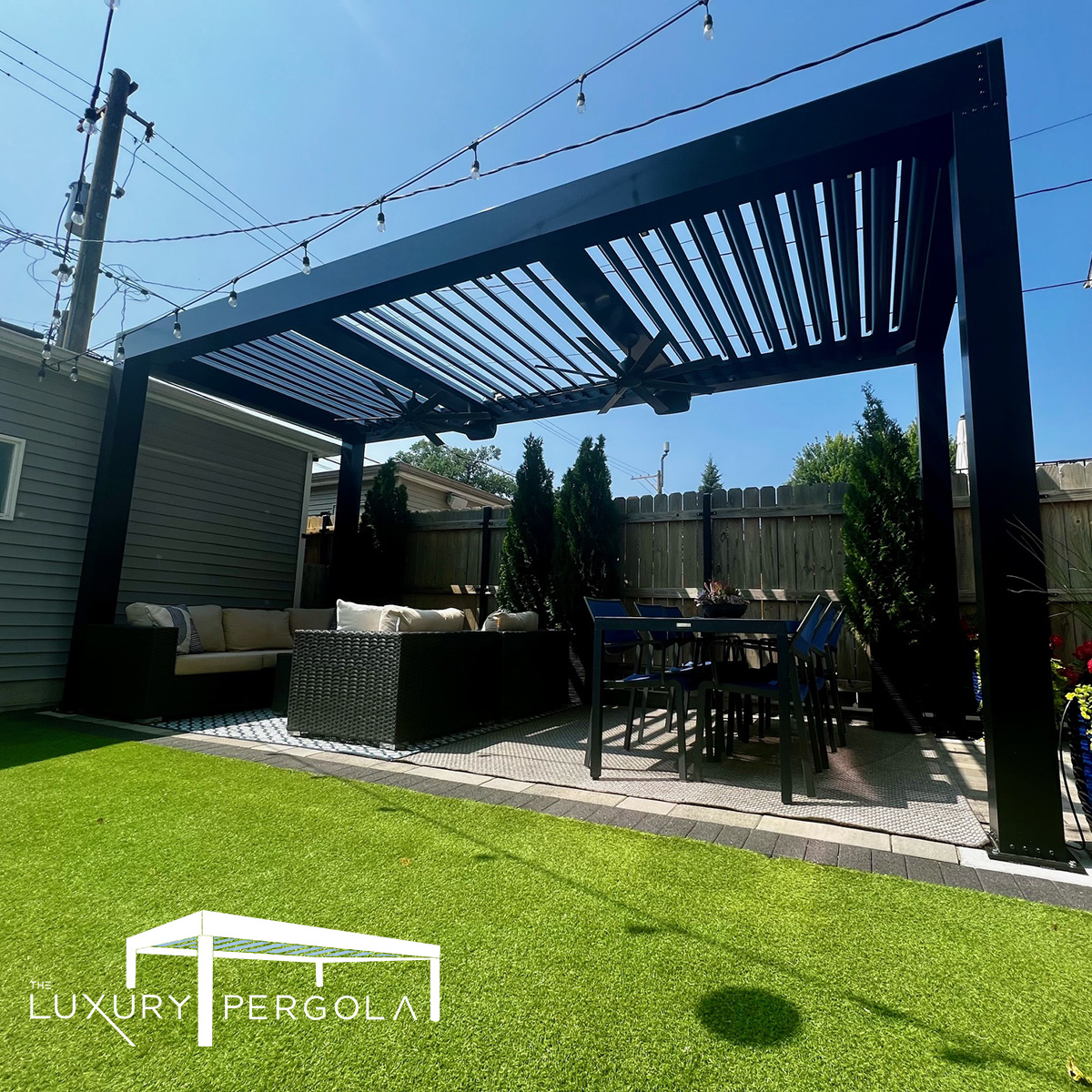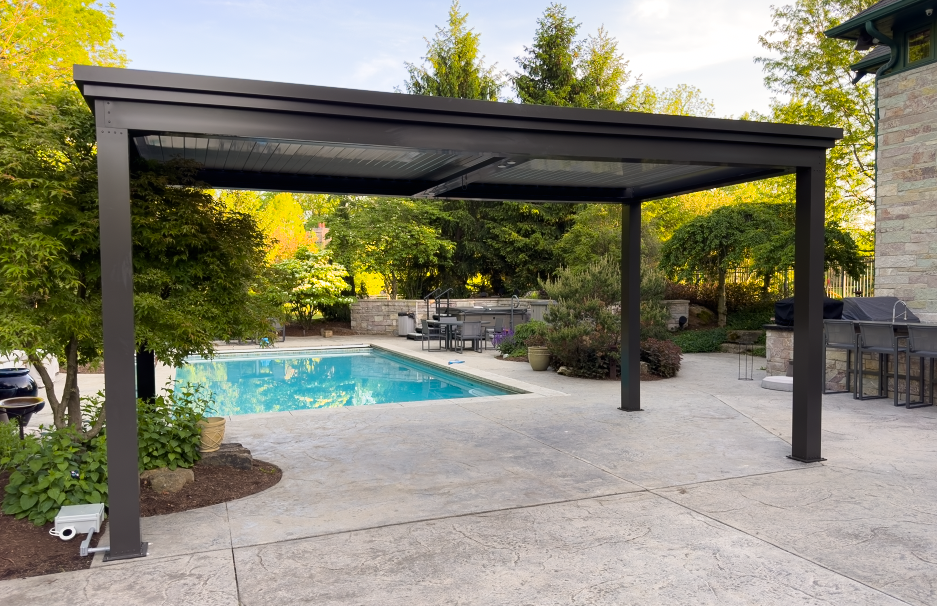Imagine relaxing in your outdoor space, enjoying the shade provided by a stylish pergola, all while knowing that it’s built to withstand the fury of a hurricane. Is that even possible? Absolutely! In this blog post, we’ll explore how to build a hurricane-proof pergola that not only looks great but is also designed to stand strong against the most powerful storms.
The minimum rating for a hurricane rated pergola is 125 mph wind rating.
Table of Contents
- Key Takeaways
- Creating a Hurricane-Resistant Pergola
- High Wind Ratings and Hurricane Force Winds
- Enhancing Wind Resistance of Your Pergola
- Louvered Roofs and Hurricane Protection
- Preparing Your Outdoor Space for Hurricane Season
- Pergola Styles Suitable for Hurricane-Prone Areas
- Summary
- Frequently Asked Questions
Key Takeaways
-
Build a hurricane-proof pergola with the right materials and design considerations.
-
Understand wind ratings & hurricane categories for maximum protection.
-
Enhance your pergola’s resistance with anchoring techniques, regular maintenance, louvered roofs & wind sensors.
-
The minimum rating for a hurricane rated pergola is 125 mph
Creating a Hurricane-Resistant Pergola

When it comes to building a wind-resistant pergola, two key factors play a crucial role: material selection and wind resistant pergola design considerations. These elements will determine whether your pergola can endure harsh weather and withstand strong winds during hurricane season.
We’ll delve into the specifics to assist you in constructing the most resilient pergola for your outdoor area.
Material Selection
Selecting appropriate materials is a fundamental step in constructing the best wind resistant pergola. Aluminum, wood, fiberglass, vinyl, and metal-reinforced vinyl are all excellent options for creating a wind-resistant pergola with wind-resistant roofing.
Aluminum pergolas are particularly popular due to their durability, ability to handle heavy loads, and resistance to strong winds. In fact, aluminum pergolas can usually handle gusts of up to 130 mph. Only the best pergolas can handle 130 mph winds, however so be careful.
Fiberglass pergolas, on the other hand, can withstand even higher wind speeds of up to 95 mph or more. Hollow core vinyl pergolas can typically handle winds up to 50-70 mph.
Ultimately, the best material for your hurricane-resistant pergola will depend on your specific needs, location, and design preferences.
Design Considerations
Beyond choosing the right materials, your pergola’s design also plays a significant role in its wind resistance. Proper anchoring is essential, as the pergola needs to be securely attached to the ground to withstand strong winds. Choosing an appropriate location and orientation can also enhance wind resistance and durability.
For example, positioning the pergola at a 45-degree angle to the prevailing wind can help reduce the impact of strong gusts. Additionally, consider connecting your pergola to a nearby building for added stability, as an attached pergola is typically more secure during high winds than a freestanding one.
High Wind Ratings and Hurricane Force Winds

Understanding high wind ratings and hurricane categories is essential for homeowners looking to build a hurricane-resistant pergola. These ratings help determine the level of protection your pergola can provide against powerful winds and extreme weather.
We’ll examine wind ratings and hurricane categories, giving you a clearer picture of what constitutes a hurricane-rated pergola.
Understanding Wind Ratings
Wind ratings indicate the maximum wind speed a pergola can withstand. For hurricane-prone areas, it’s recommended that a pergola has a minimum wind rating of 115 mph.
Various factors influence the wind rating of a pergola, such as the material, size and design, location and climate, and installation method. Knowing the wind rating of a pergola can help you make an informed decision on which pergola is best suited for your needs and location.
For example, the Luxury Pergola, made of aluminum, can withstand winds up to 130 mph, making it an excellent choice for hurricane-prone areas.
Hurricane Categories
The Saffir-Simpson Hurricane Wind Scale categorizes hurricanes based on their wind speeds, ranging from Category 1 to Category 5. Category 1 hurricanes have wind speeds between 74-95 mph, while Category 2 hurricanes feature wind speeds of 96-110 mph.
Category 3 and 4 hurricanes have hurricane winds with speeds of 111-129 mph and 130-156 mph, respectively. Higher categories indicate stronger winds and a greater potential for damage.
Understanding hurricane categories can help you ensure your pergola is built to withstand the potential wind forces in your area and prevent damage during major storms.
Enhancing Wind Resistance of Your Pergola

Employing proper anchoring methods and performing regular maintenance can significantly increase your pergola’s wind resistance. These practices will ensure that your pergola’s foundation and structure remain strong and capable of withstanding heavy winds during hurricane season.
Anchoring techniques should be tailored to the specific type of pergola you have,
Anchoring Techniques
Effective anchoring of your pergola is key to boosting its wind resistance. Here are some options for securing a hurricane-proof pergola:
-
Using concrete footings and attaching the pergola to a nearby building can provide added stability.
-
Ground anchors can be used to secure the pergola to the ground.
-
Weighted planters can be placed on the legs of the pergola to provide stability.
-
Concrete blocks can be used as leg weights to anchor the pergola.
-
Sandbags can also be used as leg weights to secure the pergola.
Additionally, drilling holes into pavers and inserting concrete anchor bolts or masonry screws can provide extra security, if applicable. It’s vital to use the appropriate anchoring techniques and materials to ensure your pergola remains firmly in place during strong winds.
Regular Maintenance
Frequent maintenance is pivotal in preserving the strength and wind resistance of your pergola’s foundation and structure. Conducting maintenance at least once a year, or more often if exposed to high winds or extreme weather, can prevent potential issues and damage.
Inspect your pergola for signs of wear and tear, check the foundation and structure for any damage, and ensure all fasteners are tight and secure. Maintaining your pergola will not only enhance its wind resistance but also prolong its lifespan and keep it looking great for years to come.
Louvered Roofs and Hurricane Protection

Louvered roofs offer an additional layer of hurricane protection for your pergola. These adjustable slats can be opened and closed to control the amount of sunlight and air entering your outdoor space, while providing protection from wind and rain.
We’ll discuss the advantages of louvered roofs and their contribution to the hurricane resistance of your pergola.
Aluminum Louvered Roofs
Aluminum louvered roofs, such as the Luxury Pergola, offer the following features:
-
Designed to withstand winds up to 130 mph
-
Unparalleled build quality
-
Durable and strong
-
Low maintenance
-
Resistant to corrosion
Aluminum louvered roofs are an excellent choice for hurricane-prone areas, providing extra protection and peace of mind during extreme weather events. Their benefits include:
-
Extra protection during hurricanes and other extreme weather events
-
Peace of mind knowing your outdoor space is secure
-
Sleek and stylish design that adds a modern touch to your outdoor space
-
Enhances the overall aesthetic of your outdoor area
Wind Sensors
Wind sensors can be added to louvered roofs for automatic adjustments during high winds, further enhancing safety and protection. These devices measure wind speed and direction, triggering the louvered roof to adjust its slats accordingly when the wind picks up. This feature can help prevent damage to your pergola and ensure your outdoor space remains safe and comfortable during powerful winds and storms.
Incorporating wind sensors into your louvered roof system is a smart investment for homeowners in hurricane-prone areas.
Preparing Your Outdoor Space for Hurricane Season

Building a hurricane-proof pergola is part of the broader task of getting your outdoor area ready for hurricane season. It’s also essential to secure furniture and decor and implement landscaping tips to minimize potential damage during extreme weather.
We’ll look at how you can prepare your outdoor space to withstand the harsh conditions of a hurricane season.
Securing Furniture and Decor
Fastening heavy furniture and decor to your deck or patio is a key step in preventing wind damage. You can use:
-
screws
-
bolts
-
other fasteners
-
straps
-
bungee cords
to anchor your outdoor items.
Additionally, perform regular maintenance and inspections to ensure the furniture and decor are secure, and that fasteners are not damaged or corroded. Taking these precautions will help protect your outdoor space and its contents during hurricane season.
Landscaping Tips

Proper landscaping can also play a significant role in minimizing potential damage during a hurricane. Trim trees and shrubs regularly to reduce the risk of them being knocked over or damaged by strong winds. Choosing wind-resistant plants, such as palms, cacti, and succulents, can further improve your outdoor space’s resilience to hurricanes and even withstand hurricane force winds.
Additionally, consider planting trees away from structures to prevent potential damage from falling branches or uprooted trees during a storm. Implementing these landscaping tips will help safeguard your outdoor space during hurricane season.
Pergola Styles Suitable for Hurricane-Prone Areas

There are various pergola styles suitable for hurricane-prone areas, including both freestanding and attached options. Customization is also available to enhance wind resistance and ensure your pergola meets your specific needs and preferences.
We’ll delve into these pergola styles and customization options to guide you in making an informed decision for your outdoor space.
Freestanding vs. Attached Pergolas
Freestanding wood pergolas offer more flexibility in design and location, allowing you to place them anywhere in your yard. However, they may be less stable during high winds compared to attached pergolas, which are connected to a nearby building for additional stability.
When properly anchored, attached pergolas can provide enhanced wind resistance and security during hurricanes. Consider your specific needs, design preferences, and location when choosing between a freestanding or attached pergola for your hurricane-prone area.
Customization Options
Customization options, such as material choice and design features, can help create a pergola that is both stylish and hurricane-resistant. Wood, aluminum, and composite materials are all suitable options for building a hurricane-resistant pergola. Design features to consider include wind-resistant roofing, anchoring techniques, and regular maintenance.
Customizing your pergola structure to suit your particular needs allows you to strike an ideal balance between aesthetics, functionality, and hurricane resistance in your outdoor space.
Summary
In conclusion, building a hurricane-proof pergola is not only possible but also a smart investment for homeowners in hurricane-prone areas. By selecting the right materials and design, ensuring proper anchoring and maintenance, and implementing additional features such as louvered roofs and wind sensors, you can create a stylish and functional outdoor space that stands strong against the most powerful storms. So, don’t let hurricanes put a damper on your outdoor enjoyment – invest in a hurricane-resistant pergola and embrace the peace of mind it provides.
Frequently Asked Questions
Can a pergola withstand a hurricane?
Considering current pergola resistance is up to 130 MPH wind resistance, it appears that pergolas can withstand most hurricanes.
What is the best pergola for hurricane protection?
For ultimate protection against hurricanes, metal pergolas are your best bet. They're durable, sturdy and built to withstand even the harshest weather conditions.
What to do with a pergola during hurricane?
Attaching the structure to a home and using a louvered roof can help buffer the pergola from strong winds during a hurricane. Consider opening the louvered roof to help eliminate potentially-damaging updrafts.
What materials are best for building a hurricane-resistant pergola?
For building a hurricane-resistant pergola, aluminum, wood, fiberglass, vinyl and metal-reinforced vinyl are all great options.
What is the minimum wind rating recommended for a pergola in hurricane-prone areas?
For hurricane-prone areas, a minimum wind rating of 125 mph is recommended.





